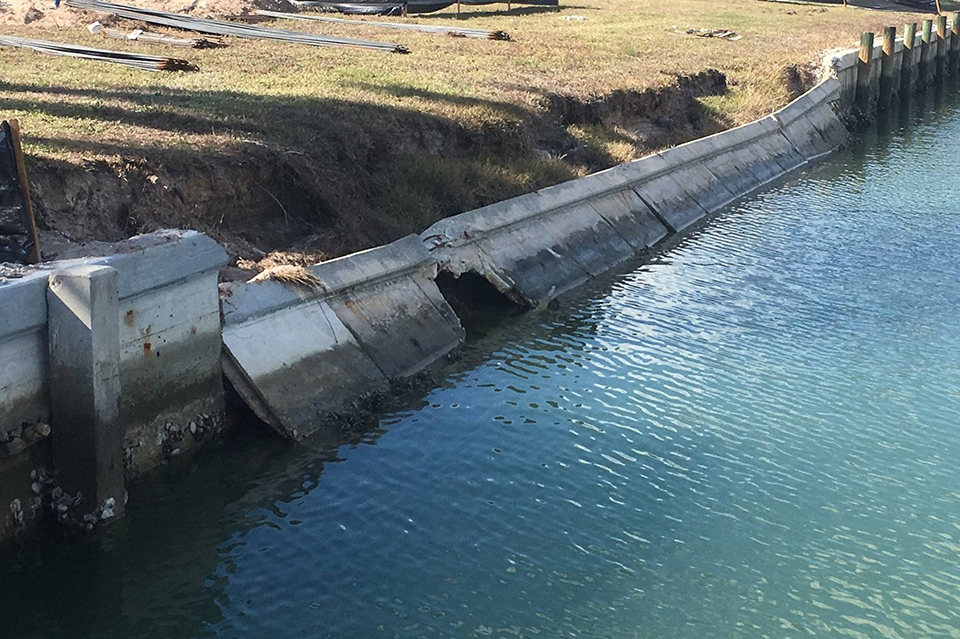When you live on beautiful, waterfront property, you want to make sure you don’t lose any of it to erosion. Unfortunately, seawall failure can compromise the safety of your waterfront while also allowing erosion to eat away at your property. Understanding why seawall failure occurs and taking steps to prevent it can protect your waterfront home.
Common Causes of Seawall Failure
There are many causes of seawall failure. Some are preventable with regular maintenance and others, such as unexpected harsh weather conditions, are unavoidable. Whenever seawall damage occurs, it’s vital to seek repairs or replacement immediately from a qualified professional.
Causes of Seawall Failure Include:
- Poor maintenance
- Lack of inspection to detect problems early
- Placing loads atop the soil supported by the seawall
- Shallow building foundations placed too close to the wall
- Changing water flow and trapping large quantities of water behind seawall
- Changing cover depth of anchor system, which diminishes seawall the anchor’s capacity
- Raising elevation and load beyond seawall design limits
- Driving heavy vehicles and/or equipment too close to seawall
- Using materials that can’t withstand harsh, corrosive marine environments
- Corrosive Nature of Marine Environments
Marine environments expose seawall materials to conditions that don’t exist outside of waterfront properties. This exposure can lead to seawall failure. A concrete seawall is exposed to chemical attacks, turbulence and crystallization forces resulting from the daily wet and dry cycles which all lead to the concrete deteriorating. This deterioration allows saltwater to get inside the concrete and reach the reinforcing steel causing corrosion and the eventual failure of the wall. This process affects all non-protected concrete including precast concrete panels, cast-in-place walls and cast-in-place top caps.
When steel sheet piling and steel anchors are exposed to the corrosive effects of saltwater, corrosion of the steel, loss of its strength and failure of the wall is inevitable.
Property Modifications That Add Weight
When you make changes to your property following the installation of a seawall, this can lead to failure of the seawall. If you add a swimming pool, hot tub, outbuilding, slab or parking area too close to a seawall, the added weight causes additional lateral earth pressure which if was not planned for in the original design may and overload the seawall. Additionally, if you raise the grade of your property, the added weight of the fill and structural modifications can stress the seawall. Any additional weight can damage or destroy a seawall that wasn’t initially built with future property modifications in mind.
Severe Weather
Although properly built seawalls follow specific designs to withstand marine environments, severe weather can place unexpected strain on the seawall. A prolonged period of heavy rain or the crashing of storm waves over a seawall on an area without proper drainage can trap water behind the seawall. This trapped water can rise up to a level higher than the waterward side and create a dramatic increase in pressure on the wall. If the seawall can’t withstand the pressure, it fails. Severe storm events can erode the toe of the wall and remove large amounts of the soil supporting the toe and keeping it stable. This soil erosion can lead to sudden or eventual failure of the seawall.
Preventing Seawall Failure
Living on a waterfront property means you have to be ready for anything and that your seawall needs to withstand the environment and weather. Utilizing the services of experienced seawall contractors who use innovative materials such as Truline sheet piling helps ensure the longevity of your seawall. Truline can withstand harsh marine conditions better than traditional materials. The steel-reinforced concrete of Truline provides versatility and strength. It also gives you and the seawall designer the ability to create and build a seawall able to withstand all anticipated conditions.
Protect your property from erosion and storm damage by installing a seawall that utilizes the durability and reliability of Truline sheet piling.

